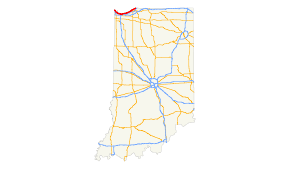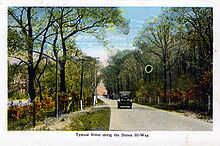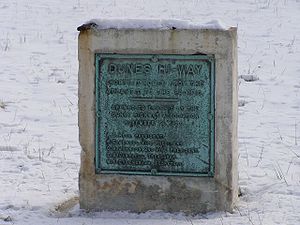- U.S. Route 12 in Indiana
-
"IN 12" redirects here. For the former congressional district, see Indiana's 12th congressional district.This article is about the section of U.S. Route 12 in Indiana. For the entire length of the highway, see U.S. Route 12.
U.S. Route 12 
Route information Maintained by INDOT Length: 45.16 mi[1] (72.68 km) Major junctions West end: 

 US 12 / US 20 / US 41 in Chicago at the Illinois state line, beneath
US 12 / US 20 / US 41 in Chicago at the Illinois state line, beneath 
 I-90 / Ind. Toll Rd.
I-90 / Ind. Toll Rd. I-65 in Gary
I-65 in Gary

 I-90 / Ind. Toll Rd. in Gary
I-90 / Ind. Toll Rd. in GaryEast end:  US 12 Michigan state line
US 12 Michigan state lineHighway system United States Numbered Highways
List • Bannered • Divided • ReplacedIndiana roads
Interstates • U.S. Routes • State Roads • Former←  SR 11
SR 11SR 13  →
→In the U.S. state of Indiana, U.S. Route 12 is a historical east–west arterial highway that runs along the Lake Michigan shoreline. In the early 1920s, it was the most important route between Chicago, Illinois and Detroit, Michigan. Most of the route has since been supplanted by Interstate 94 and the Indiana Toll Road.
The total length of U.S. 12 in Indiana is approximately 45.16 miles (72.7 km).[1]
In Indiana, the highway has been designated as the Iron Brigade Memorial Highway to honor the Civil War Union Army unit; a designation it also has in Michigan, Wisconsin and Illinois. [2] [3] [4][5]
Contents
Route description
U.S. Route 12 can be characterized in the following sections:
Whiting to Gary
This portion of U.S. 12 largely consists of industrialized sections of Whiting. It begins concurrent with U.S. Route 20 and U.S. Route 41. In Whiting, U.S. 41 branches south, following the eastern side of Wolf Lake. U.S. 12/20 continues southeast through a field of Amoco oil storage tanks. South of the storage tanks, U.S. 20 continues south and turns east south of Interstate 90 (Indiana Toll Road), while U.S. 12 runs east, and then southeast towards the Gary/Chicago International Airport.
U.S. 12 then runs below the Toll Road at the Little Calumet River. It closely parallels U.S. 20 on the west side of Gary, then joins with it at Bridge Street. Through Gary, U.S. 12/20 runs westbound on 4th Avenue, and eastbound on 5th Avenue. It also has intersections with the Toll Road at Buchanan Street and State Road 53 (Broadway).
East of downtown Gary, U.S. 12/20 has a signalized intersection with the northern terminus of Interstate 65.
Through this part of northwest Indiana, U.S. 12 consists of four lanes (two westbound, two eastbound), and widens to six lanes when concurrent with U.S. 20.
Gary to Michiana Shores
In the far eastern portion of Gary, U.S. 12/20 split for the final time, although U.S. 20 closely parallels U.S. 12 for the next 20 miles (32 km), sometimes coming within 0.2 miles of intersecting. U.S. 20 follows a slightly more southerly route to Michigan City (via Portage and Porter) while U.S. 12 passes through the Indiana Dunes National Lakeshore and retains the name "Dunes Highway." After splitting from U.S. 20, U.S. 12 has only two lanes, one westbound and one eastbound, although it widens to four lanes between Ogden Dunes and Burns Harbor. It intersects State Road 249 and State Road 149 the industrial complex at Burns Harbor, which includes a NIPSCO power plant and a steel mill.
The "Dunes Highway" is the name for a section of Route 12 that is largely located within Porter County, Indiana. The Dunes Highway begins on the east side of Gary, Indiana (specifically, Interstate 65), travels through Portage, Indiana and ends on the west side of Michigan City, Indiana one half mile (0.8 km) east of the LaPorte County line, near Mount Baldy. The Dunes Highway carries U.S. Route 12 near, but not on or within sight of, the shoreline of Lake Michigan.
This segment of U.S. 12 is about 25 miles (40 km) long. As the predecessor to Interstate 80, Interstate 90 and Interstate 94, this segment of road between Detroit, Michigan and Chicago, Illinois was one of the most important and most heavily traveled roads from 1899 through 1922.[6]
The Dunes Highway is considered the gateway to Lake Michigan's picturesque dunes of northern Indiana and western Michigan. Access is provided to the dunes via the National Park Service's entrance to West Beach of the Indiana Dunes National Lakeshore, at the boundary between Lake and Porter counties. The State of Indiana Department of Natural Resources runs Indiana Dunes State Park, located further east at Indiana State Route 49. East of the State Park, there are additional points of access to the National Lakeshore beaches in and near Beverly Shores, at Kemil Road, Central Avenue and Mount Baldy.
At Indiana Dunes State Park, U.S. 12 has an interchange with State Road 49. In the Town of Pines, U.S. 12 intersects with State Road 520, which is the final connecting route to U.S. 20 before the two separate regionally.
In Michigan City, U.S. 12 intersects with the northern terminus of U.S. Route 35. (This will end in October 2009, when US 35's terminus is moved east to US 20.[7] The change was approved by AASHTO on October 17, 2008.[8]) Before exiting Indiana, U.S. 12 intersects State Road 212, an eastern bypass of Michigan City, and then travels through Michiana Shores.
History of the Dunes Highway[9]
"One important project was the 1900 to 1910 macadamizing of part of the Old Chicago Road, Northwest Indiana's major auto route between Gary and Michigan City before the Dunes Highway. In a 1954 Chesterton Tribune article, C.W. Nelson noted that a 12-foot (3.7 m)-wide macadam section of the Old Chicago Road was laid after the turn of the century from his Baillytown family farm north of the present U.S. 12 and west of the current Bethlehem Steel entrance gate to earlier sections of pavement at Highway 49. Macadam was the best road surface available for most of the 19th century. However, automobile tires created grooves in macadam roads, which yielded in the 1920s to asphalt and concrete surfacing."[10]
As more cars hit the road the Chicago Motor Club, founded in 1906, began marking what it considered the best route between Detroit and Chicago. Club members designated what locals referred to as the Old Chicago Road Seven-A-Route to assist drivers without detailed road maps. They placed signs at intersections to help motorists negotiate Seven-A-Route's many right angle turns. For example, from Oak Hill Road travelers on the Chicago Road proceeded east as far as "the high bridge" on the present Old S.R. 49, then north to the present U.S. 20, then east to the Carver School Road, then north for a mile, then east to Michigan City. The circuitous road punctuated by numerous grade crossings made driving slow and treacherous. These conditions kindled desires for a more efficient thoroughfare which eventually led to the construction of The Dunes Highway.[11]
Works Projects Administration writers attributed the genesis of the "Dunes Highway" to 1919 government surveys for an improved road along the lakeshore following the old Detroit State Road route.[12] But Gary Post-Tribune columnist Tom Cannon credited Henry M. Miles, Michigan City engineer, with the idea for a national highway along the South Shore interurban line between Gary and Michigan City. Miles' 1918 speech to the Michigan City Chamber of Commerce, "Trunk Line Highways," appealed to the business community's concerns for more efficient transportation and commerce. Soon Gary Commercial Club members caught Dunes Highway fever. A.H. Hess, chairman of the Commercial Club Good Roads committee, organized the Dunes Highway Association to lobby state highway commission officials for the new road. Representatives from the West Michigan Pike Association and Illinois' Sheridan Drive Association attended the initial January 20, 1919, meeting of the Dunes Highway Association. They saw the Dunes Highway bridging Lake Michigan's western and eastern shores to the straits of Mackinac. Gathering momentum, the Dunes Highway Association launched an intensive public relations campaign assisted by Cannon's Gary Post-Tribune articles.[13]
Dunes Highway Association engineers envisioned the Dunes Highway a "state of the art" 40-foot (12 m)-wide concrete highway with a 100-foot (30 m) right-of-way. Therefore, the new road would have closely adhered to proper road design and construction specifications suggested by leading highway engineers for an Ideal Section of the transcontinental Lincoln Highway. Engineers conceived this transportation innovation after the 1916 passage of the Federal-Aid Road Act. In 1922, the 1⅓-mile Ideal Section was built in Lake County beginning at Dyer on the Illinois-Indiana border. This section of pavement was designed to carry automobiles traveling 35 miles (56 km) an hour and motor trucks 10 miles (16 km) an hour on average. The State Highway Commission did not accede to the Dunes Highway Association's wishes for a model road like the Ideal Section. In August 1919, Commission director H.L. Wright tentatively designated the Dunes Highway as State Road 43, to be 20 feet (6.1 m) wide. Narrower than anticipated, the new concrete highway was still superior to most Indiana roads, which in the mid-1920s were gravel or dirt with paved sections only between the larger towns.[14]
Dunes Highway construction began in 1922 under the guidance of Gary contractor Ingwald Moe and construction engineer Ezra Sensibar. Both public and private funding defrayed the approximately $1 million construction cost of the Dunes Highway. The new road qualified under the 1921 Federal Highway Act for matching government funds. This legislation replaced the original Federal-Aid Road Act of 1916 to more stringently restrict the distribution of highway funds. The law required that states earmark for federal funding less than 7 percent of the state's entire highway mileage. Indiana's total road mileage in 1921 was 73,131 miles (117,693 km). Consequently, only 5,000 miles (8,000 km) of state roads could receive federal funding. The Hoosier State Automobile Association also claimed responsibility for financing the Dunes Highway, soliciting businesses along the road to support construction. The Michigan City News-Dispatch reported that the local business community paid an $11 membership fee to defray Dunes Highway construction expenses. Realizing the benefits of a road linking regional industries, the Consumers' Company, a sand mining enterprise, and Inland Steel Company donated rights-of-way through their property.[15] [16] [17]
See also: Sauk Trail and Chicago RoadMajor junctions
County Location Mile[1] Destinations Notes Lake Whiting 0.00 

 US 12 / US 20 / US 41 – Chicago
US 12 / US 20 / US 41 – ChicagoIllinois state line 0.06 
 I-90 east / Ind. Toll Rd. – South Bend, Toledo
I-90 east / Ind. Toll Rd. – South Bend, ToledoWestbound exit and eastbound entrance 1.34  US 41 south (Calumet Avenue) – Hammond
US 41 south (Calumet Avenue) – HammondEast Chicago 4.41 Riley Road To SR 912 5.16  US 20 east – Michigan City
US 20 east – Michigan City7.78-
8.00 SR 912 (Cline Avenue)
SR 912 (Cline Avenue)8.48  SR 312 (Chicago Ave.)
SR 312 (Chicago Ave.)Gary 11.35  US 20 west – East Chicago
US 20 west – East Chicago11.94 
 US 12 east / US 20 east
US 12 east / US 20 eastWestern end of one-way traffic 13.74  SR 53 (Broadway) – Merrillville
SR 53 (Broadway) – Merrillville14.37 
 US 12 west / US 20 west
US 12 west / US 20 westEastern end of one-way traffic 15.32  I-65 south – Indianapolis
I-65 south – IndianapolisNorthern terminus of I-65 15.37-
15.74
 I-90 / Ind. Toll Rd. – South Bend, Chicago, Toledo
I-90 / Ind. Toll Rd. – South Bend, Chicago, Toledo16.71  US 20 east – Michigan City
US 20 east – Michigan CityPorter Burns Harbor 23.41-
23.65 SR 249 south (George Nelson Drive)
SR 249 south (George Nelson Drive)25.05  SR 149 south (Max Mochal Hwy.)
SR 149 south (Max Mochal Hwy.)28.75-
29.80 SR 49 south
SR 49 southPines 34.84 
 SR 520 south (Maple Street) to US 20
SR 520 south (Maple Street) to US 20La Porte Michigan City 43.45-
43.54
 SR 212 south to US 20
SR 212 south to US 2045.16  US 12 – Detroit
US 12 – DetroitMichigan state line 1.000 mi = 1.609 km; 1.000 km = 0.621 mi
Concurrency terminus • Closed/Former • Incomplete access • UnopenedReferences
- ^ a b c "INDOT Roadway Referencing System". http://www.in.gov/indot/2376.htm.
- ^ http://www.legislature.mi.gov/(S(5id4cfbly5xxly45mymm1245))/mileg.aspx?page=getObject&objectName=mcl-250-1048
- ^ http://www.dot.wisconsin.gov/travel/road/commemorative.htm
- ^ http://www.in.gov/indot/3005.htm
- ^ http://americanroadmagazine.com/forum/index.php?showtopic=958
- ^ Unknown (2004-04-13). "Busiest Road in the World". http://members.tripod.com/~Ogden_Dunes/duneshwy/. Retrieved 2006-01-27.
- ^ Indiana Department of Transportation (2008-08-25). "An Application from the State highway or Transportation Department of Indiana". http://www.transportation.org/sites/route/docs/Indiana%20-%20US%2035.pdf. Retrieved 2008-10-27.
- ^ AASHTO (2008-10-27). "Committee action and approvals". http://www.transportation.org/?siteid=68&pageid=1540. Retrieved 2008-10-27.
- ^ Development of U.S. 12 - `The Dunes Highway'; National Park Service; August 2005
- ^ C.W. Nelson, "On the Old Chicago Road," Duneland Historical Society Newsletter, February, 1957, 1-7; Suzanne Hayes Fischer, "Facilities For Motorists, 1900–1940, Historic Context & Property Type Analysis" (Masters essay, Indiana University/Purdue University, 1994), 12; John A. Jakle, The Tourist, Travel in Twentieth-Century North America (Lincoln, Nebraska: University of Nebraska Press, 1985), 130-132; Dena Sanford and Brenda Williams, Historic Properties Summary, Indiana Dunes National Lakeshore (Omaha: National Park Service, 1996), 3.
- ^ Fischer, Suzanne Hayes. "Facilities for Motorists, 1900–1940, Historic Context Study & Property Type Analysis." Masters essay. Indiana University/Purdue University, Indianapolis, 1994.
- ^ U.S., Federal Writers Project. The Calumet Region Historical Guide. East Chicago, 1939.
- ^ The Gary Post-Tribune, November 16, 1923
- ^ The Gary Post-Tribune, November 16, 1923; Rose, 88; Fischer, 12.
- ^ Gary Post-Tribune, November 16, 1923; The News-Dispatch, September 12, 1996.
- ^ Rose, Albert C. Historic American Highways: Significant Incidents in the Development of Highway Transportation in Colonial America and the United States During More Than Four Centuries. Washington: American Association of State Highway Officials, 1953.
- ^ Indiana. Executive Department, Division of Accounting and Statistics. Yearbook of the State of Indiana. Fort Wayne: State Of Indiana, 1917-40.
 U.S. Route 12
U.S. Route 12Previous state:
IllinoisIndiana Next state:
MichiganU.S. Highways in Indiana North–South US 27 • US 31 • US 33 • US 35 • US 41East–West US Auxiliary Route US 131 • US 136 • US 150 • US 224 • US 231 • US 421US Auxiliary Route Former Other Roads in Indiana Categories:- U.S. Route 12
- U.S. Highways in Indiana
- Transportation in Gary, Indiana
- Lake Michigan Circle Tour
- Northwest Indiana
- Transportation in Lake County, Indiana
- Transportation in Porter County, Indiana
- Transportation in LaPorte County, Indiana
Wikimedia Foundation. 2010.









